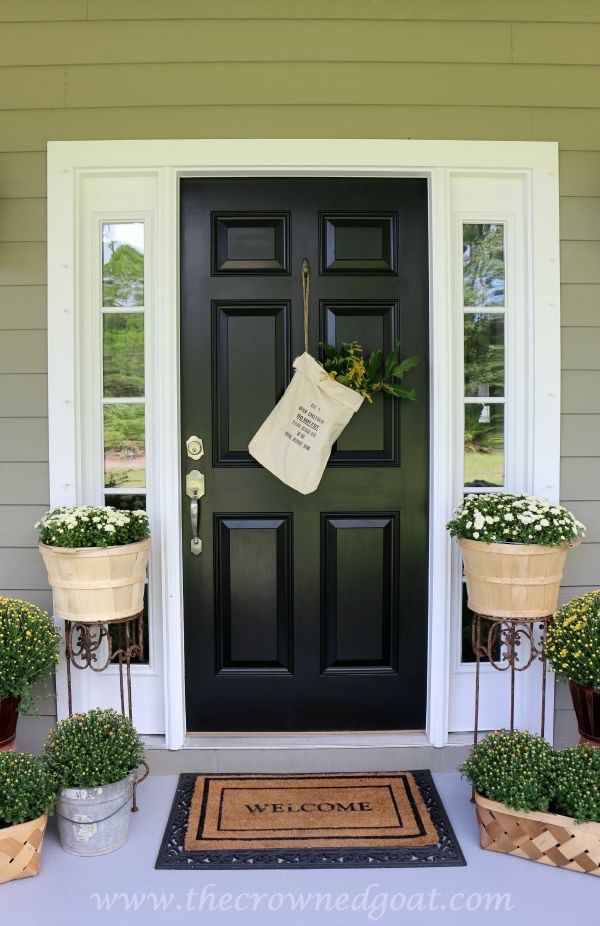Growing plant cuttings
how to root plant cuttings in water for propagation
Hello! Thanks for being here! Today I’m going to show you how to root plant cuttings in water. This is a great way of multiplying the plants you have and sharing the plant love with friends. I will say, it’s kind of hard to give away a plant that you’ve been nursing from its beginning. But, it’s so rewarding and so cool to get results! I just gave two Chain of Hearts cuttings away today to super awesome homes. I can’t wait to check in on their progress.
When I was in my early 20s I worked at a golf course that had a 30 foot Monstera deliciosa. You read that right…30 FEET! That’s where my love of plants began. It’s actually my favorite plant of all time (if you didn’t already know). Anyway, some of the leaves were 2 feet wide and absolutely beautiful! One day I saw this tiny leaf pop out of soil and when no one was looking, I brushed the dirt away from the shiny green stem and plucked it right out of there! I kept looking watch over my shoulders like I was about to pull a bank job or something. I mean, I guess technically it was stealing. But I didn’t see it that way. I was spreading the love! But let’s make something perfectly clear, IT IS STEALING WHEN YOU DO IT AT A STORE so don’t do that! I ended up telling my supervisor (it was weighing on my conscience) and he laughed, told me I was silly, and that it was totally fine! All this to say, I took it home, put it in water, it rooted, and it made me so happy! I was so in love with this amazing method of reproduction. Let’s talk about How to Root Plant Cuttings in Water.
Most common house plants can be propagated by water method. Right now my new subject is a tiny little stem from my big Fiddle Leaf Fig. So far no roots but there is a tiny green leaf!! If you’re not sure, just try it!
Let’s get started
- Identify the location where you will snip your cutting from the main plant. Not all cutting that will root in water have root nodes, but most of them do so find the root node on your plant.
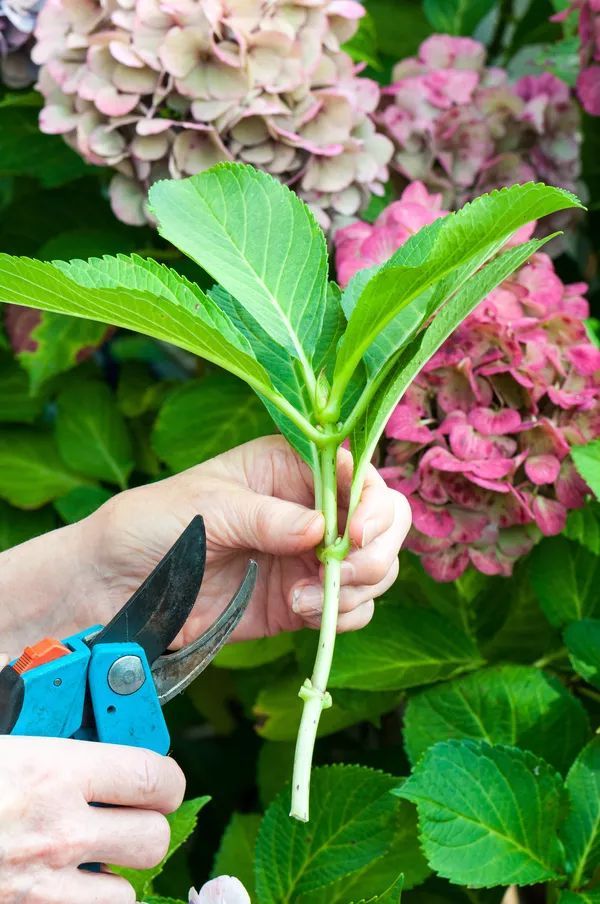
- Carefully cut just below the node with a clean sharp knife or scissors. About 1/4″ below the node.
- Place the cutting in a clean glass. Poor enough room temperature water to cover the nodes of the cutting.
- Change out the water every 3-5 days with fresh room temperature water.
- Wait and watch as your roots grow! This can take weeks to months depending on the plant.
- Once your roots reach approximately 3″-5″ then it’s time to put the cutting in soil!
Need a visual? Watch my propagation tips on AM Northwest.
Place your rooting plants in an area with bright indirect light. You’ll also need patience…serious patience! If you are trying a new cutting and two weeks go by with no roots, it’s not always bad news. I know someone who stuck a fiddle leaf fig leaf in water and 3 months later she started to see roots.
When you change out the water, be sure to give the roots a little rinse and a little rub with your fingers. The roots can get a mucky film (that’s the technical term) and you want to wipe that away before placing them in the new water.
The roots can get a mucky film (that’s the technical term) and you want to wipe that away before placing them in the new water.
That’s all you have to do! It’s so simple. Now you can make your own plants and trade with your friends. It’s one of my most favorite things to do. Once you are ready to pot your rooted plant, check out my How to Repot a Houseplant post. I know you won’t be actually repotting but there are some good tips about potting in general. Thank you so much for visiting! See you next time!
Check out my Instagram for daily plant love and inspiration!
This post has affiliate links for your convenience
How to Grow Plants From Cuttings
Grow New Plants at Home With This Easy Propagation Method
By
Marie Iannotti
Marie Iannotti
Marie Iannotti is a life-long gardener and a veteran Master Gardener with nearly three decades of experience. She's also an author of three gardening books, a plant photographer, public speaker, and a former Cornell Cooperative Extension Horticulture Educator. Marie's garden writing has been featured in newspapers and magazines nationwide and she has been interviewed for Martha Stewart Radio, National Public Radio, and numerous articles.
She's also an author of three gardening books, a plant photographer, public speaker, and a former Cornell Cooperative Extension Horticulture Educator. Marie's garden writing has been featured in newspapers and magazines nationwide and she has been interviewed for Martha Stewart Radio, National Public Radio, and numerous articles.
Learn more about The Spruce's Editorial Process
Updated on 10/25/22
Reviewed by
Kathleen Miller
Reviewed by Kathleen Miller
Kathleen Miller is a highly-regarded Master Gardener and Horticulturist who shares her knowledge of sustainable living, organic gardening, farming, and landscape design. She founded Gaia's Farm and Gardens, a working sustainable permaculture farm, and writes for Gaia Grows, a local newspaper column. She has over 30 years of experience in gardening and sustainable farming.
Learn more about The Spruce's Review Board
The Spruce / Jiaqi Zhou
Project Overview
Garden plants can be propagated in many ways, but one of the easiest methods is taking stem cuttings. How to grow plants from cuttings is simple: Trim off a healthy portion of stem, place it in water or a growing medium until it develops roots, and then plant it in a pot or the ground.
How to grow plants from cuttings is simple: Trim off a healthy portion of stem, place it in water or a growing medium until it develops roots, and then plant it in a pot or the ground.
Growing plants from cuttings is a common way to create new houseplants, but it can also work for many garden plants. In cold-weather zones, some gardeners take clippings of tender annuals and root them indoors to prepare a supply of new plants for garden planting in the spring.
Here's what to know about how you grow a plant from a stem cutting.
Watch Now: How to Propagate Dipladenia
When to Take Stem Cuttings
Stem cuttings can be taken and rooted at almost any time during the parent plant's active growth period. You also can take cuttings from many woody plants (plants with hard stems) during their dormancy. In cold climates, you can take cuttings in the fall before frost arrives, root them indoors, and then transfer them to pots. By springtime, you will have vigorous potted plants that can go back into the garden.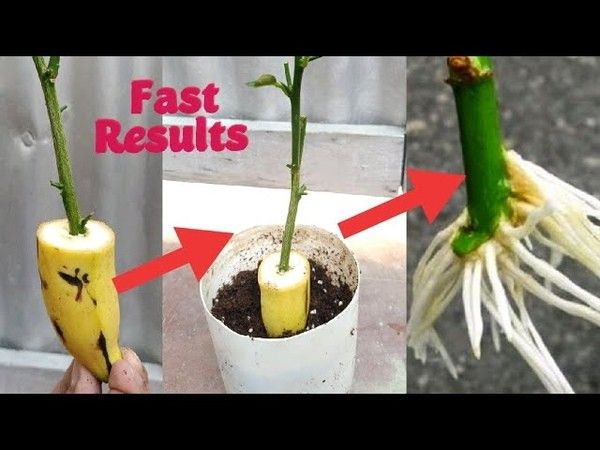
Types of Plants to Grow From Cuttings
Soft-stemmed herbaceous plants are the easiest to grow from cuttings, but many woody plants can also be propagated with this method. The following list includes examples of plants that grow from cuttings.
- Semi-hardwood cuttings are woody around their base but have softer stems up top. Examples of plants that can be propagated via semi-hardwood cuttings include holly, hydrangeas, and azaleas.
- Hardwood cuttings have woody stems throughout. Examples of plants that can be propagated via hardwood cuttings include crepe myrtle, forsythia, and rose species.
- Softwood cuttings have flexible soft stems. Examples of plants that can be propagated via softwood cuttings include clematis, asters, and chrysanthemums.
- Greenwood cuttings are very similar to softwood cuttings, except that their base is slightly harder and they take a bit longer to grow.
 Examples of plants that can be propagated via greenwood cuttings include boxwoods, dahlias, and gardenias.
Examples of plants that can be propagated via greenwood cuttings include boxwoods, dahlias, and gardenias.
Before You Begin
The key to successful rooting of stem clippings is to find the moisture and temperature level appropriate for each type of plant. Do some research on the species you are trying to propagate to learn the conditions it likes best. You can make your plant cuttings grow faster not only by providing the conditions they like but also by applying rooting hormone to the cut end, which helps to encourage root production. It's also best to take several clippings to maximize your chances of success.
How long plant cuttings take to root varies widely depending on the type of plant. Many herbaceous annuals will quickly grow to maturity. But cuttings from perennials and woody plants, such as shrubs, can be harder to root and take longer to reach maturity.
Tip
It is possible to grow a plant from a cutting in water. Simply place the cut end down in a container partially filled with plain water, and refresh the water every few days until a substantial root system has formed. However, transferring a water-rooted seedling to soil is not always successful, so it's generally better to plant cuttings straight into soil.
However, transferring a water-rooted seedling to soil is not always successful, so it's generally better to plant cuttings straight into soil.
Equipment / Tools
- Razor blade or scissors
- Small container for rooting hormone (optional)
- Pencil or stick
Materials
- 6-inch containers for planting
- Soilless potting mix
- Existing plant (parent plant)
- Alcohol
- Rooting hormone (optional)
- Plastic bag
The Spruce / Loren Probish
How to Grow Plants From Cuttings
-
Prepare a Container
Fill a clean 6-inch-deep container with soilless potting mix to hold cuttings for rooting. A soilless mix drains well and provides suitably moist conditions that encourage the cutting to root. Don't use ordinary garden soil, as it might contain pathogens that can kill the cutting before it ever takes root.
The Spruce / Loren Probish
-
Choose a Parent Plant
Select a healthy parent plant from which to take cuttings.
 Avoid plants with diseases or lots of drooping or dying foliage. The best specimens for cuttings will have plenty of new growth and be large enough that taking cuttings will not harm them.
Avoid plants with diseases or lots of drooping or dying foliage. The best specimens for cuttings will have plenty of new growth and be large enough that taking cuttings will not harm them. Tip
Good green growth is more important in a parent plant than plentiful flower buds. Too many flowers can actually hinder the ability of a cutting to grow roots.
The Spruce / Loren Probish
-
Find the Best Stems for Cutting
Choose green, soft (non-woody) stems for cuttings. Newer growth is easier to root than woody, older stems. Look for a stem with a node—a bump along the stem where a leaf or flower bud attaches. This point is where new roots will emerge.
The Spruce / Loren Probish
-
Take the Plant Cutting
Use a pair of scissors or a razor blade that has been sterilized in alcohol to make a clean cut just below a node. The cutting doesn’t need to be long, but it should contain at least two leaves and one node.
 A cutting that is 4 to 6 inches long is usually sufficient. Longer cuttings sometimes dry out when placed in their growing medium.
A cutting that is 4 to 6 inches long is usually sufficient. Longer cuttings sometimes dry out when placed in their growing medium. The Spruce / Loren Probish
-
Prepare the Cutting
Place the cutting on a flat, hard surface, and make a clean, partial slice through the middle of the node with a sterilized razor blade. Scarring the node will increase the chances of roots emerging from this spot.
Then, remove all but one or two leaves on the cutting. The cutting needs some leaf growth to continue photosynthesis, but too many leaves will consume energy that would otherwise go to root creation. If the leaves are very large in proportion to the stem, cut off the top halves of the leaves.
The Spruce / Loren Probish
-
Apply Rooting Hormone (Optional)
Wet the node end of the cutting, and then dip it in a small container of rooting hormone. Tap off any excess hormone; too much actually hinders chances for success.
 This step is optional. Some plants root easily on their own, but rooting hormone can help others by stimulating the cutting into sending out new roots.
This step is optional. Some plants root easily on their own, but rooting hormone can help others by stimulating the cutting into sending out new roots.The Spruce / Candace Madonna
-
Bore a Planting Hole
Use a pencil or similar pointed object to poke a planting hole into the potting mix, rather than planting the cutting straight into the soil. Make the hole slightly larger than the stem diameter. Doing so will prevent rooting hormone from being wiped away when you embed the stem in the pot, and it's also gentler on the stem.
The Spruce / Loren Probish
-
Plant the Cutting in the Soil
Carefully plant the cutting in the hole you made in the potting mix, and gently tamp the soil around it. You can fit several cuttings into one container, but space them so the leaves do not touch one another.
The Spruce / Loren Probish
-
Cover the Pot With Plastic
Place the container with the cutting into a plastic bag.
 The bag will keep the humidity high and hold in heat. But don’t seal the bag completely because some airflow is necessary to prevent fungal rot.
The bag will keep the humidity high and hold in heat. But don’t seal the bag completely because some airflow is necessary to prevent fungal rot. Keep the container in a warm spot in the house, ideally in an area that has indirect bright light. Don’t put the cutting in full sunlight until new leaves begin appearing along the stem.
The Spruce / Loren Probish
-
Monitor the Cutting
Until roots form, keep the soil slightly moist but not so wet that condensation forms on the inside of the plastic bag. Check regularly for signs of rot, and remove any suspect cuttings as soon as you spot trouble.
After two to three weeks, begin checking for roots by tugging gently on the cutting. When you begin to feel resistance, it means roots have developed. At this point, you can transplant the cutting into its own pot or the ground.
The Spruce / Loren Probish
30 Plants That Grow From Cuttings in Soil
Watch Now: 19 Timelapses Perfect for Plant Lovers
Article Sources
The Spruce uses only high-quality sources, including peer-reviewed studies, to support the facts within our articles.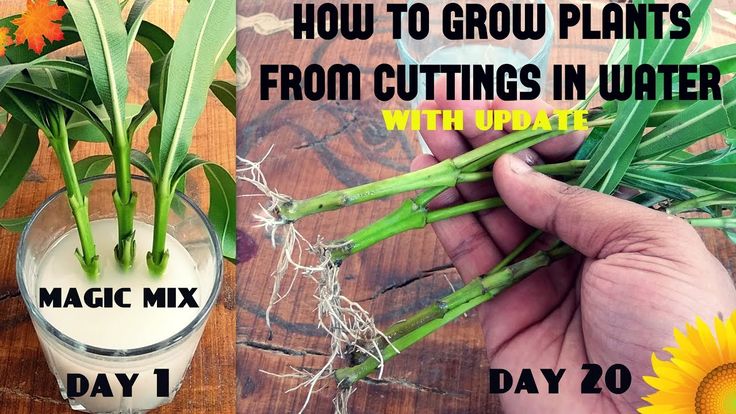 Read our editorial process to learn more about how we fact-check and keep our content accurate, reliable, and trustworthy.
Read our editorial process to learn more about how we fact-check and keep our content accurate, reliable, and trustworthy.
Plant Propagation. University of Maine Extension.
Plant cuttings: several effective ways
Plant cuttings are also known as cloning. This propagation method assumes that some part is taken from the mother plant, for example, a leaf or a shoot. Further, this part is placed in a favorable environment, where it develops roots.
Cutting at home does not require large financial costs and has a number of advantages:
- Compared to seedlings, cuttings enter the vegetative phase faster. nine0008
- When grown under artificial light, clones can be brought to color earlier, resulting in harvest time much sooner than with seeds.
- Cloning makes it possible to obtain plants with predictable genetic characteristics that will be completely borrowed from the "donor", while with seeds, the size, appearance and yield of the plant will be much more unpredictable.

It seems to many inexperienced flower growers that it is enough to cut off the shoot, put it in water and wait for the roots to appear. But in such conditions, not every species can take root, often the cuttings simply rot. nine0003
To get strong and healthy plants through vegetative propagation, it is important to choose the right cutting, cut it correctly, and also avoid mistakes when planting it and in subsequent care.
Plant cuttings: methods
Before harvesting clones, it is worthwhile to understand in more detail how this is done for a particular species. Cuttings of indoor plants are carried out in three ways: using stems, leaves or roots. nine0003
You need to choose which part to take, starting from the variety. Unfortunately, some plants cannot be propagated in this way at all. But almost all species reproduce perfectly by stem cloning. Such a cutting will consist of a stem, buds and foliage. The clone will take root at the cut site, and new shoots will sprout from the buds.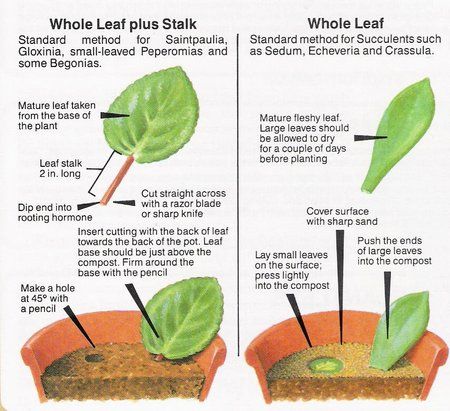
Before the procedure, prepare suitable dishes and soil for rooting, as well as check the serviceability of all devices that you plan to use. You can keep the cuttings under lamps such as ESL or LL with a cold color spectrum (6500 K). The recommended light regime is 18/6. In the early stages of development, clones should not receive too much light, as this will become stressful for them. Therefore, if development takes place under the sun, choose a place for cuttings in the shade. nine0003
You should not cut off thin stems with scissors, although this seems to many to be the most convenient option, but in this way the cut point will be compressed, which injures plant tissues. As a result, the stalk, most likely, will begin to rot. It is better to cut the stems with a sharp knife or scalpel, and a pruner is suitable for stiff shoots.
It is important to cut cuttings only from completely healthy plants, and they should not be in the flowering phase. It is advisable to treat the cut site with a root growth activator, which will significantly speed up the process. nine0003
nine0003
Plant cuttings: workflow
The process of cutting or cloning your green pets is done in this order:
- We sterilize a knife, scalpel or secateurs, that is, those tools that will be in direct contact with the cuttings.
- We prepare the growing medium: you can take mineral wool, moisten it with a buffer solution (this will help remove excess alkali from this material) and squeeze it out slightly to prevent excess nutrients. nine0008
- Select a donor. The mother plant should not be sick or blooming.
- Cut a side branch with at least three internodes.
- Use the scalpel to prepare the clones. So, you need to remove the bottom pair of leaves to avoid decay, and just below the last internode, a cut is made at an angle of 45.
- If the plant has large foliage, it is worth trimming the leaf blades by a third or half. This is done so that too much moisture does not evaporate through them. In addition, too large leaves may wither in the first days after planting.
 nine0008
nine0008 - Cut cuttings should not be immediately sent to water or soil, most plants need clones to lie down for a couple of hours in the open air. Or you can put a fresh cut in a rooting powder or gel like Hesi Clonfix, Clonex or MaxiClon.
- Immerse the clone in the prepared medium, for this a hole is made, in which the cutting should be placed approximately one third. In addition to mineral wool, you can take the Root Riot cube. nine0007 A heated mat or a transparent cap that covers the cuttings helps to increase the success of the process. This is necessary to maintain the optimum temperature (21-25°C) and humidity level (80-90%).
- Spray the clones daily with water or foliar application, and irrigate the media with a nutrient solution of EC 0.3-0.8 (about a third of the standard dosage). It is important to avoid overflows and immediately remove rotten leaves.
Usually, the first roots hatch after a week and a half, which depends on the type and variety of the plant.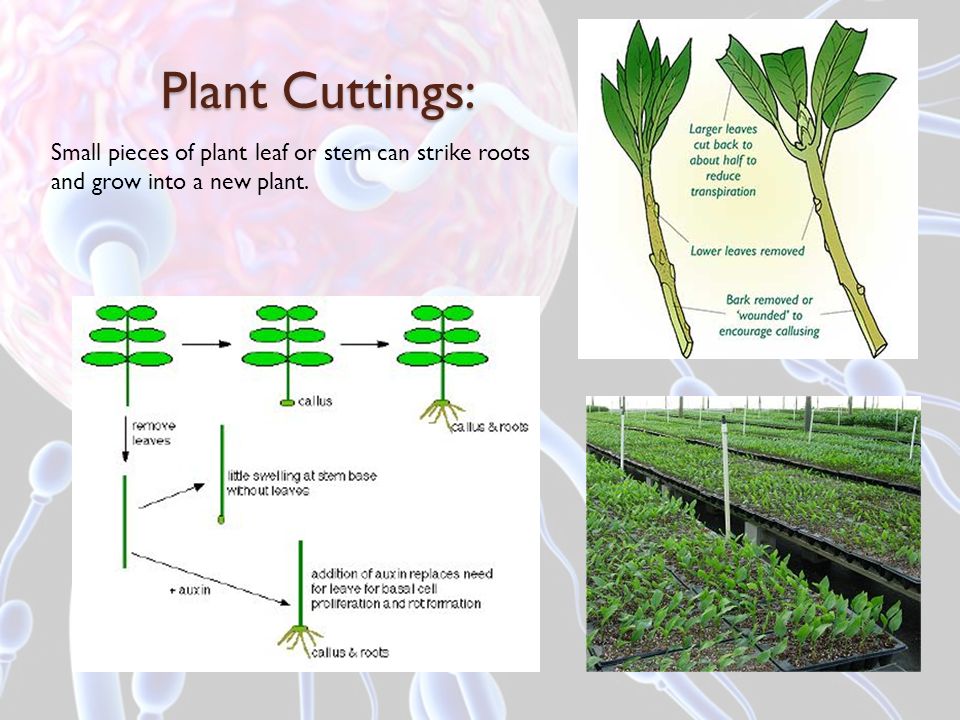 After their appearance, you need to gradually "accustom" clones to future conditions. However, sudden changes in temperature, humidity, amount of lighting and nutrients should not be allowed, otherwise the cuttings may die. nine0003
After their appearance, you need to gradually "accustom" clones to future conditions. However, sudden changes in temperature, humidity, amount of lighting and nutrients should not be allowed, otherwise the cuttings may die. nine0003
If we talk about the optimal moment for harvesting clones, then the lunar calendar for cutting plants will come to the rescue. The most favorable time for this procedure is at the junction between the first and second phases of the moon, that is, from 6 to 9 lunar days.
How to root cuttings?
In addition to all the tips above. It is worth remembering the following rules for cutting plants:
- Firstly, the less capricious culture the florist deals with, the more likely it is that the cutting will take root even in plain water, but the classic method of rooting is in the ground. nine0008
- Secondly, species whose natural environment is tropical forests or swamps perfectly form roots in water, but it is better to immediately place the “resident” of arid places in the soil.
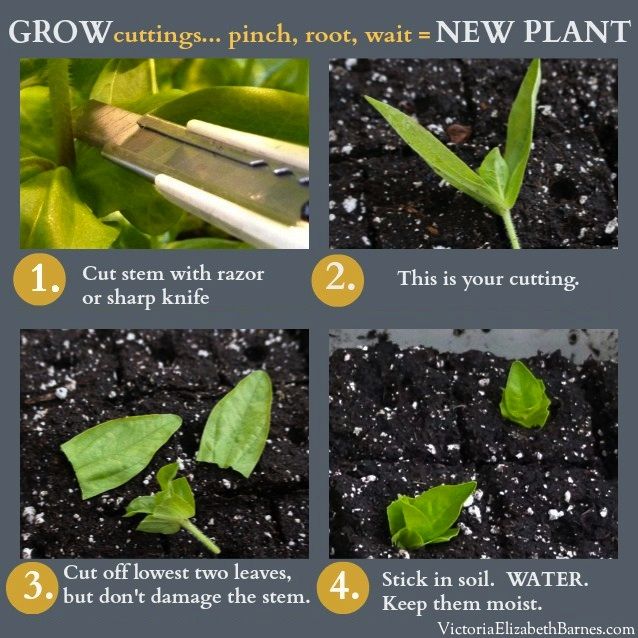
Beginners often think that rooting in the substrate is more difficult than in water, but this is not the case. The cuttings are simply placed in recesses previously made with a small spatula or stick, cut down. It is important not to compact the soil or place the clones too close together. Next, a small watering is carried out and a cap is installed. nine0003
As for top dressing, its amount should be increased gradually until it reaches the dosage, as in the vegetative stage. It is also necessary to remove the cap for about half an hour 1-2 times a day. Later, the cuttings should be kept open longer and more frequently until they are ready to be transplanted.
Water rooting
First you need to take any plastic or glassware of small sizes. A glass of dark glass is best: in this case, the roots form faster. The stems are placed in such a way that the lower part does not sink too deep, because the roots appear precisely at the border of air and water. nine0003
nine0003
By the way, it is not necessary to take boiled water for rooting cuttings; regular tap water is also suitable. Boiling is supposedly necessary for disinfection, but, in fact, microorganisms enter the liquid immediately after the cutting is placed in it. There are also more than enough germs in the air.
The main rule here is not to change the water under the cuttings completely, but only top it up if necessary. Often the cuttings die immediately after changing the water. This is due to the fact that a stable environment is formed from the waste products of the plant in a glass, which contributes to the development of roots. The best thing you can do to prevent rot is to throw activated charcoal into a glass. nine0003
It is not recommended to place more than two cuttings in one container. The more capricious the plant is, the fewer stems should be in one glass. As a rule, it is worth starting to rot one cutting, and the rest die.
CUTTINGS IN A JAR | Science and life
Growing plants from cuttings is the most popular method of vegetative propagation.
Bud and leaf cuttings can be cut from any shoot - green, semi-lignified or lignified. nine0003
‹
›
View full size
It would seem that what else can be written in addition to the numerous manuals on rooting cuttings? But when you start cutting yourself, you discover a lot of little things that decisively affect the result.
The easiest way to root is in a jar of water. Under certain conditions, it can be used even for plants that are considered difficult to root. But for all the simplicity of this method, there are many little things on which success depends. nine0003
For example, not all plants tolerate water changes. In order to avoid possible failure, it is better not to change the water, but only to add it when it evaporates. Apparently, it accumulates some metabolic products necessary for the plant. I have repeatedly had to observe the death of blue passionflower cuttings that have already given roots after changing the water, even if the water was well-settled and did not contain any harmful impurities.
Equally important is the number of cuttings in the bank. Honeysuckle does not want to take root if there are more than three cuttings per 200 ml of water, but one at a time in a jar of even smaller volume, the same cuttings perfectly give roots. nine0003
Growing plants from cuttings is the most popular method of vegetative propagation. Left - nodal stalk. Its lower cut is located directly under the node or kidney. This is how green unripened stems are usually cut, since the tissues located in this place are more resistant to fungal diseases. A cut in the middle of the internode (on the right) is made, as a rule, when cutting cuttings from more mature lignified shoots.
Interestingly, the ability of a plant to produce rooted cuttings depends on the nutrition of the mother plant. If it received nitrogen in excess, the roots on the cuttings form very poorly. It is also difficult to form roots in plants that are "starved". For the most active root formation, the mother plant must be fully provided with potassium, phosphorus and slightly less nitrogen. nine0003
nine0003
It is also important from which shoots the cuttings are taken. Fattening, powerfully growing shoots give poor quality cuttings. So do not chase power and size, cuttings take root much better from lateral, not very strong growing branches. But it is curious that in some conifers, the place where the cutting is taken affects the shape of the future plant. From the cuttings from the lateral horizontal branches of the spiky yew, disheveled or even almost creeping plants are obtained, and from vertically growing cuttings - vertical ones. Similar phenomena have been observed in the cuttings of spruce trees. nine0003
For easily rooted plants, the age of the mother plant does not play a role, but for those plants that are difficult to root, this is very important. The older the "parent", the worse, in most cases, its cuttings take root. At a young age, cuttings are even taken from plants that are not accepted to be cut, for example, apple trees and pears, in which, when treated with heteroauxin (a root formation stimulator), apical cuttings taken from annual seedlings easily root.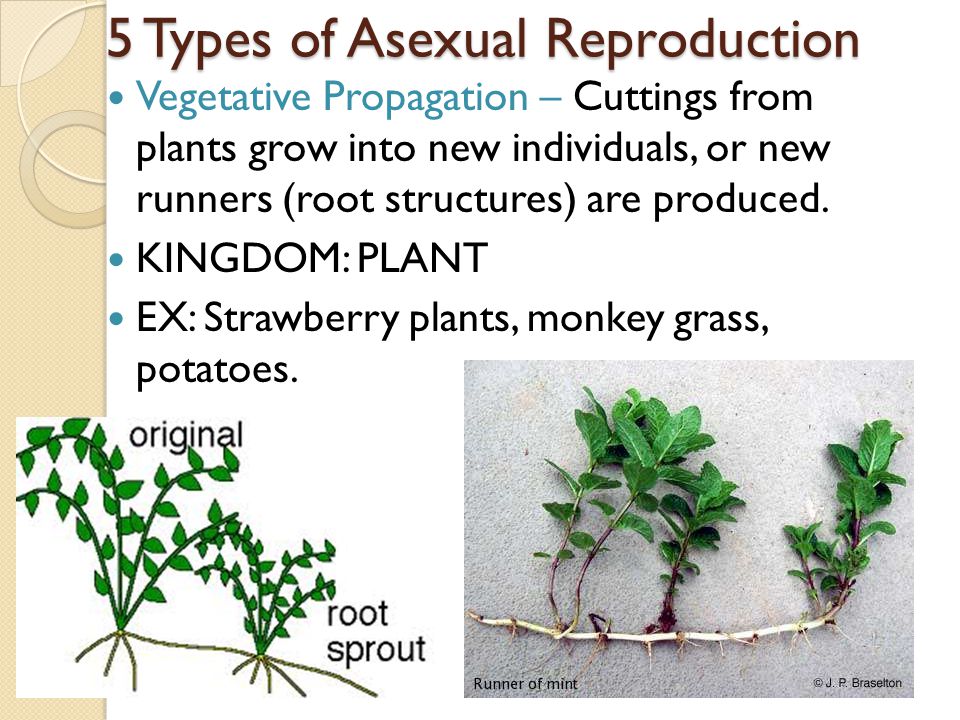 But the ease of root formation in cuttings harvested from annual branches decreases with increasing tree age, even when treated with stimulants. Moreover, some plants with age completely lose the ability to vegetative reproduction. This happened in our garden with petiolate hydrangea, which gave excellent layering 20 years ago, and now even buried branches of the bush do not take root. nine0003
But the ease of root formation in cuttings harvested from annual branches decreases with increasing tree age, even when treated with stimulants. Moreover, some plants with age completely lose the ability to vegetative reproduction. This happened in our garden with petiolate hydrangea, which gave excellent layering 20 years ago, and now even buried branches of the bush do not take root. nine0003
Cuttings, consisting of a bud with a leaf, can be cut from any shoots - green, semi-lignified and lignified. The upper cut is made as close as possible to the kidney, if possible, without leaving a hemp. The lower one is 2.5-4 cm from the upper one. Each cutting should consist of one leaf (the other leaf is removed), a bud located in its axil, and a very short segment of the stem.
It is also not indifferent from which part of the shoot the cutting is taken. Often, very long shoots are taken for cuttings, from which a large number of cuttings are immediately cut with secateurs. The lower the segment of the stem from which the cutting is taken is located, the better it takes root in most plants. Once I had to take cuttings from the same passionflower branch. Despite the fact that the entire branch was equally lignified, only the last cutting, taken from its very base, took root. The same can be observed in such a frequently cutting plant as a rose. nine0003
Once I had to take cuttings from the same passionflower branch. Despite the fact that the entire branch was equally lignified, only the last cutting, taken from its very base, took root. The same can be observed in such a frequently cutting plant as a rose. nine0003
Light has a great influence on the rooting of cuttings. A cutting that has no leaves grows better roots in the dark. To root a cutting that has at least a piece of a leaf left, light is needed. But even in the light in an opaque dish, the roots form much better than in a light jar. It is believed that a cutting harvested from a branch during the period when there are no leaves already contains some heteroauxin, which, apparently, decomposes in the light. If there are leaves, it is they who produce the rooting stimulator heteroauxin. It would be possible to leave all the leaves on the cuttings, but, being in the water, and even more so when rooting in the substrate, when the water supply is limited, the extra leaves dry out the cuttings and they may die.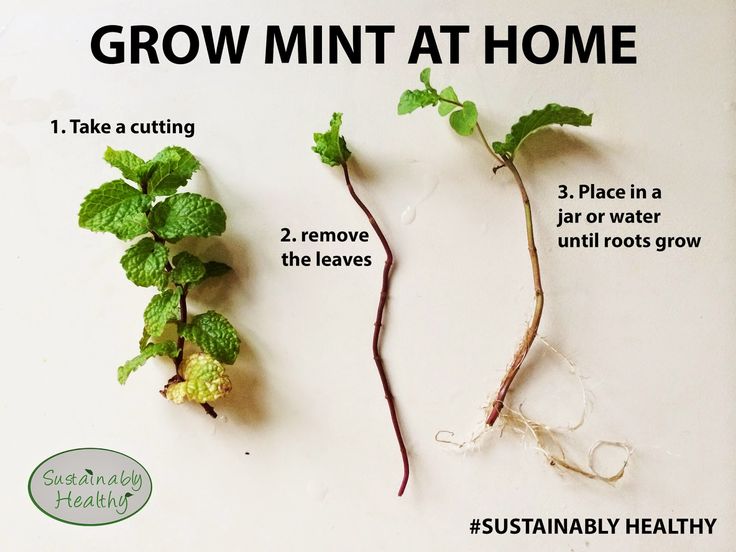 nine0003
nine0003
The level of water in the bank is also important. If there is too much water, there is not enough oxygen near the bottom, and this can cause rotting of the lower part of the cuttings: after all, roots form only at the border of water and air. The experiments of the British showed that the roots appear much faster and along the entire length of the cuttings in the bank, if the water was aerated.
And one more interesting observation. Many plants reproduce best when they are dormant. Blackcurrant cuttings planted in the ground in autumn take root much better than spring ones, which almost completely die. Sea buckthorn propagates well by winter cuttings. Cut off at the end of January - February, sea buckthorn sprigs give roots in one or two weeks in a jar of plain water or water to which honey is added. A tablespoon of honey is diluted in a glass of water and the cuttings are placed in the solution for 6-12 hours. The main mistake of gardeners during the winter cuttings of sea buckthorn is its too late transplantation into the soil.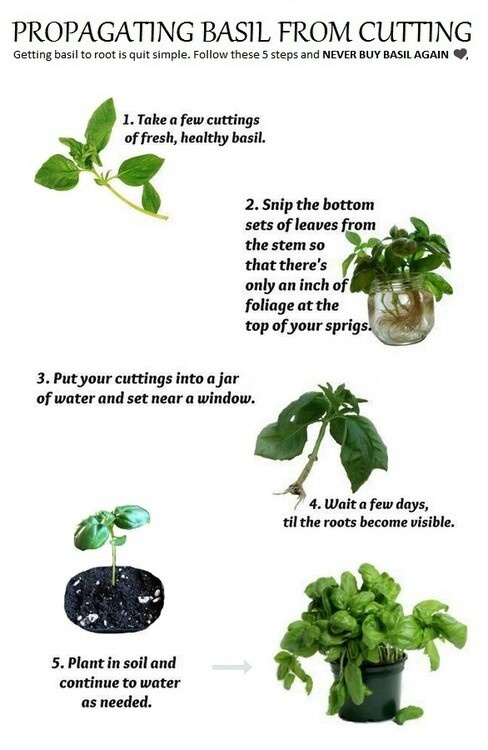 Roots on cuttings grow very quickly, they become too long and break off when transferred to the garden. nine0003
Roots on cuttings grow very quickly, they become too long and break off when transferred to the garden. nine0003
Excellent roots in ordinary vases with water were given by long branches of yew berry and western thuja cut in February and March for a bouquet (about 60 cm long and about a centimeter in diameter). In May - June, all of them with well-developed roots were planted in the ground.
And one more curious cutting method, which has recently been common among amateur gardeners.
Take a large potato tuber and carefully remove all the eyes from it. The cuttings are stuck directly into the tuber, buried in the ground and covered with a glass jar to create a greenhouse effect. With regular watering, cuttings quickly give roots, and young plants planted in the garden develop well. So it is possible to root even poorly cutting plants. The method is quite justified, since instead of water, the cuttings immediately receive a large amount of ready-made nutrients, in particular carbohydrates, including starch.




